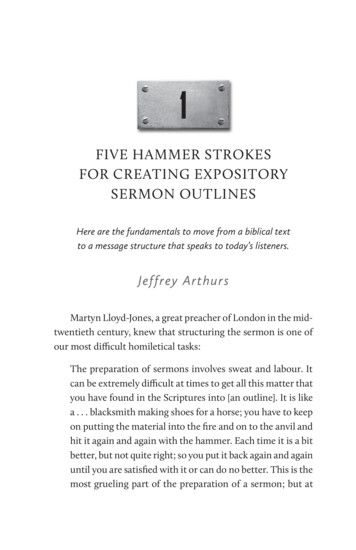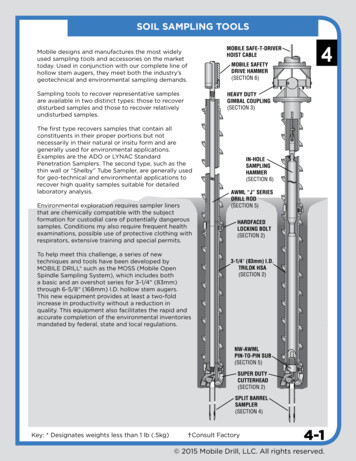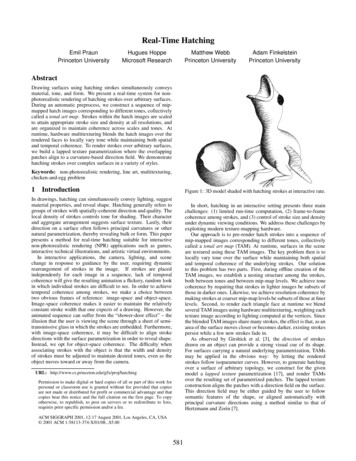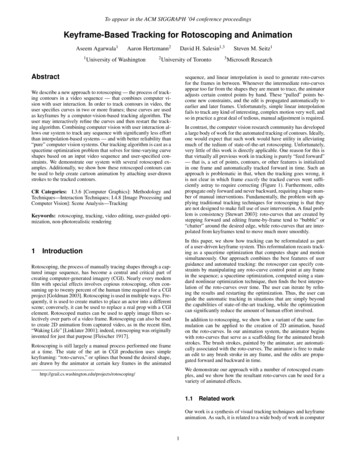
Transcription
1Five Hammer Strokesfor Creating ExpositorySermon OutlinesHere are the fundamentals to move from a biblical textto a message structure that speaks to today’s listeners.Jeffrey ArthursMartyn Lloyd-Jones, a great preacher of London in the midtwentieth century, knew that structuring the sermon is one ofour most difficult homiletical tasks:The preparation of sermons involves sweat and labour. Itcan be extremely difficult at times to get all this matter thatyou have found in the Scriptures into [an outline]. It is likea . . . blacksmith making shoes for a horse; you have to keepon putting the material into the fire and on to the anvil andhit it again and again with the hammer. Each time it is a bitbetter, but not quite right; so you put it back again and againuntil you are satisfied with it or can do no better. This is themost grueling part of the preparation of a sermon; but at
J e f f rey A rt h ursthe same time it is a most fascinating and a most gloriousoccupation. (Preachers and Preaching, 80)This article can’t (and shouldn’t) stop the sweat and labor,but it can help you strike skillfully. When pastors begin their sermon prep (and, unfortunately, sometimes when they end theirsermon prep), the text often seems to be, as Hamlet said, “words,words, words.” The relationships among the words—the ideaspresented—are hard to discern and even harder to package forthe congregation. The purpose of this article is to help us makesense of the words and structure them in a way that makes senseto the listeners. As homiletical blacksmiths, five strokes of thehammer help us structure our sermons.First stroke: state the exegetical outlineSummarize the flow of thought in your text. We call thisthe exegetical outline, and it is part of basic exegesis. If youhave gotten away from that discipline, get back to it. Charting the flow of thought with a mechanical layout, grammaticaldiagram, or semantic structural analysis is an indispensible stepin creating an expository sermon. Simply identifying a generaltheme is not enough to reveal authorial intention. Laying outthe major ideas and their relationships will help you identifythe unifying core of the text, what Haddon Robinson calls theexegetical idea.Once you articulate that idea, then you can turn it into yoursermon’s “big idea.” In essay writing this is called the thesis. Inpublic speaking it is called the central idea. The big idea is thedistilled essence of the message. Compare the exegetical idea (thetext’s central truth) and the big idea (the sermon’s central truth):4
FIVE HAMMER STROKES FOR SERMON OUTLINESExegetical ideaBig ideaPurpose—to summarize thepassage in a single sentencePurpose—to communicate themessage of the passage in asingle sentence so that it aidscomprehension and lodges inmemorySounds like a commentarySounds like a proverbAs long as necessary foraccuracy and thoroughnessFifteen words or fewerThird personFirst or second personPast tensePresent tenseExample from Psalm 32:Example from Psalm 32:Cover or be covered.The psalmist praised God forthe forgiveness he receivedafter confessing his sin,because blessing attends theone whose sins are covered byGod, but woes attend the onewho tries to cover his own sin.I believe that every sermon should have a big idea for tworeasons. The first relates to sound hermeneutics. Conservativeexegetes believe in authorial intention—that the biblical authorsintended to convey ideas to their readers. In any thought unitsuch as a paragraph in an epistle or a scene in a narrative, theauthor wanted to get a point across. To be sure, texts have manyideas, but our job in exegesis is to discern how those ideas relateto each other. They swirl around a central point. Texts are not arandom hodgepodge. Stating the exegetical idea helps us articulate authorial intention. My second reason relates to communication. Sermons are most effective when they are laser focused.When the preacher cuts extraneous fat, listeners comprehendclearly. Reducing the essence of the sermon to one idea will increase its impact.5
J e f f rey A rt h ursAs you outline the text’s flow of ideas, you can expect to seethe following patterns of thought, common to human experience: problem-solution cause-effect contrast (not this, but this) chronology (first this happened, then this, then this) promise-fulfillment lesser to greater argument-proof explanation-application principle-example/amplificationOther patterns undoubtedly exist, and once you train yourmind to think in logical categories like these, discerning flow ofthought becomes second nature. Some of the patterns above useinductive reasoning, and some use deductive reasoning. Induction starts with particulars and moves toward a conclusion orprinciple. The first six patterns are inductive. Deduction startswith the conclusion or axiom and then explains, proves, or applies that idea. The last three patterns are deductive.Here is an exegetical outline for James 4:13–17, with commentary on the flow of thought in italics:I. Some ofJames’s readers boasted about tomorrow (v. 13).Effect: The passage begins inductively with an example ofboasting. This is the effect of the cause James will identifylater in the passage (arrogance). The author places a hypothetical speech in the mouths of the readers to show themwhat arrogance sounds like.6
FIVE HAMMER STROKES FOR SERMON OUTLINESII. James rebukes such boasting (v. 14).Contrast: In contrast to the wealth of knowledge implied inthe boastful opening speech, the readers actually know little.They do not know the future. They are as fragile as mist. Thelogical flow from verse 13 to verse 14 is contrast: not this,but this.III. James contrasts boastful speech with submissive speech(v. 15).Contrast continued: The author continues with the logicof contrast by creating another hypothetical speech. Thissecond speech shows proper words that are submissive andhumble, in contrast with the opening speech.IV. The readers boast because they are arrogant (v. 16a).Cause: The author has described and illustrated the effect (boasting), and now he reveals the cause: arrogance.Westerners normally think in terms of cause-effect, but thereverse, effect-cause, is also possible.V. Boasting is evil, and anyone who knows this, but persistsin boasting, sins (vv. 16b–17).Summary: James pulls the camera back to present the broadlandscape. He ends by summarizing the previous exhortation about boasting. (Another possibility is that he providesfurther argumentation why the readers should not boast.)Here is an exegetical outline for Psalm 32:I. Blessed is the one whom the Lord has forgiven (vv. 1–2).Announcement of theme: David summarizes the wholepsalm with this headline.II. When the author tried to cover his own sins, the Lorddisciplined him (vv. 3–4).7
J e f f rey A rt h ursProblem: David describes the trouble his silence brought—the Lord’s heavy hand of discipline. Tradition says that thispsalm grew out of David’s personal experience—his sins ofadultery and murder, and his attempt to cover his own sins.After the announcement of the theme, he describes how miserable he was when he refused to confess.III. Then the author confessed, and God forgave (v. 5).Solution: After experiencing the discipline of God, Davidfinally confessed and experienced the blessings described inverses 1–2. The logical (and somewhat chronological) flow moves fromClear structuretrouble to grace, problem to solution.of the sermondepends oncrystal clearunderstandingof the flowof thought inthe passage.IV. The author urges others tofollow his example and experienceGod’s deliverance (vv. 6–11).Exhortation: David exhorts the readers to learn from his experience. Thewicked experience sorrow, but the loveof God surrounds the ones who trusthim. Therefore, confess!Clear structure of the sermon depends on crystal clear understanding of the flow of thought in the passage. Do not rush thisfoundational step in your exegesis.Second stroke: rephrase (and possibly reorder)the points as a homiletical outlineUsing John Stott’s metaphor of “standing between twoworlds,” the exegetical outline resides in the world of the text,and the homiletical outline resides in the world of the listener.Compare:8
FIVE HAMMER STROKES FOR SERMON OUTLINESExegetical outlineHomiletical outlinePast tensePresent tenseThird personFirst or second personSummarizes the author’sthoughtSummarizes your thought fromthe text for the congregationFollows the textual orderexactlyUsually follows the textual order,but can also follow “thoughtorder”I’ll illustrate the last item in this chart in a moment, but firstlet me illustrate the top three items. In the examples that follow, notice that the outline no longer sounds like a commentary(“James told his readers to do such and such”; “David did this orthat”). Rather, it sounds like a living soul addressing living souls.Here is a homiletical outline from James 4:13–17:I. Sometimes we boast about tomorrow (v. 13).II. We should not do this, because our knowledge is limitedand our days are short (v. 14).III. Big idea: Rather than boasting, we should speak withhumility and submission to God’s will (v. 15).IV. The cause of our boasting is arrogance (v. 16a).V. Now that you know this, if you continue to boast, you sin(vv. 16b–17).Here is a homiletical outline from Psalm 32:I. Big idea (summary): Blessed is the one whom the Lordhas forgiven (vv. 1–2).II. Problem: When we refuse to confess our sins, we bake inthe oven of discipline (vv. 3–4).9
J e f f rey A rt h ursIII. Solution: Confess your sins, and God will forgive (v. 5).IV. Exhortation: Listen to God’s wisdom and experienceGod’s deliverance (vv. 6–11).To return to the issue above—the issue of textual order andthought order—consider this helpful example from DonaldSunukjian (summarized from Invitation to Biblical Preaching,56–64):Textual order: “Don’t get mad when the paperboy throwsyour paper in the bushes.” The arrangement is response(don’t get mad) to cause (the paperboy throws your paperin the bushes).Thought order: A sermon from this “text” could rearrangethe textual order into the more natural thought order ofcause-response. This would help the listeners follow the sequence of ideas. Thus:I. Cause: Sometimes the paperboy throws your paper in thebushes.II. Response: When that happens, don’t get mad.Although expository preachers usually adhere to textualorder, rearranging the points of the expository outline cansometimes help us stand between two worlds. Rearrangementcan help us clarify the meaning of the text.Here are two examples from the texts above. First is a homi letical outline from James 4:13–17, rearranged for inductivethought order:I. Our knowledge is limited, and our days are short (v. 14).Transition: Yet . . .10
FIVE HAMMER STROKES FOR SERMON OUTLINESII. In our arrogance we boast (vv. 13, 16a).Transition: Therefore . . .III. Such boasting is sin (vv. 16b–17).Transition: In contrast . . .IV. Big idea: We should speak with humility and submissionto God’s will (v. 15).The flow of thought in the outline above moves inductively.Starting with the assertion that we are fragile creatures, limitedand ephemeral, the sermon’s final point is the big idea. The sermon has driven toward the big idea.Another homiletical outline could be arranged deductively,stating the big idea first. For example, here is a homileticaloutline from James 4:13–17 rearranged for deductive thoughtorder:I. Big idea: We should speak with humility and submissionto God’s will (v. 15).Transition: Why? Because . . .II. Our knowledge is limited, and our days are short (v. 14).Transition: Yet . . .III. In our arrogance we boast (vv. 13, 16a).Transition: Therefore . . .IV. Such boasting is sin (vv. 16b–17).Here is a homiletical outline for Psalm 32 rearranged for deductive thought order:I. Big idea (solution): Confess your sins (v. 5).Transition: As a result . . .11
J e f f rey A rt h ursII. Result: Experience God’s deliverance (vv. 1–2).Transition: In contrast . . .III. Problem: When we refuse to confess our sins, we bake inthe oven of discipline (vv. 3–4).Transition: Therefore . . .IV. Exhortation: Listen to God’s wisdom, and experienceGod’s deliverance (vv. 6–11).The example above states the big idea early in the sermon andthen returns to it in the last point. The next example, a homiletical outline of Psalm 32 rearranged for inductive thought order,saves the big idea until the last point:I. Problem: When we refuse to confess our sins, we bake inthe oven of discipline (vv. 3–4).Transition: In contrast, what we truly desire is . . .II. Contrast: When we allow God to cover our sins, we knowpeace (vv. 1–2).Transition: Therefore . . .III. Big idea (solution): Confess your sins (v. 5).Transition: As a result . . .IV. Exhortation: Listen to God’s wisdom, and experienceGod’s deliverance (vv. 6–11).The examples above demonstrate that expository preachershave latitude when it comes to structure. Our normal procedure, once again, is to follow the exegetical outline when creating the homiletical outline, but pastoral wisdom will sometimessuggest that we rearrange the points into a different order.12
FIVE HAMMER STROKES FOR SERMON OUTLINESThird stroke: develop the pointsNow that you have summarized the text’s flow of thoughtand have rephrased (and possibly reordered) the points, put fleshon the bones. Develop the ideas by addressing the questions thelisteners will ask. (See Haddon Robinson, Biblical Preaching, 2nded., 75–96.) If they ask:Listeners’ questionPreacher’s responseWhat does that mean?You must explain. The preachertakes the stance of a teacher.Is that true?You must defend/prove. Thepreacher takes the stance of anapologist.So what?You must apply. The preachertakes the stance of an equipperor exhorter, urging behavioralresponse.This stage of structuring a clear and effective sermon demands audience analysis. You have to know the listeners’ levelof knowledge, belief, and submission to the text. Listen to thepoints of your outline through the ears of your listeners.Furthermore, these three developmental questions are psychologically sequential. That is, people will often believe whathas been clearly explained to them, and they will often do whatthey believe. Conversely, they are unlikely to believe what theydo not understand; and they will not act upon what they do notbelieve. I have discovered that many people will respond to thegospel in faith and repentance if we simply explain it clearly.But if we cloud their understanding, they will neither believenor respond. Our Lord says in this regard: “When anyone hearsthe word of the kingdom and does not understand it, the evil13
J e f f rey A rt h ursone comes and snatches away what has been sown in his heart”(Matt. 13:19, esv, italics added).Understanding—when well established, often leads to . . .Agreeing—when well established, often leads to . . .RespondingWe fulfill all three functions—explaining, proving, and applying—by taking the truth to every seat, with Story, Example,Analogy, and Testimony (SEAT). Remembering that the humanmind is a picture gallery, not just a debating chamber, we standbetween the words of the text and the hearts of the people bycommunicating frequently at the bottom of the ladder of abstraction, using concrete support material. This means that youtake a general truth, such as “God values justice,” or a vague exhortation, such as “be good,” and bring that truth down to terrafirma, the world of your listeners. (See Figure 1.1.)To explain 1 Thessalonians 4:3 (“Avoid sexual immorality”),we could state an abstract definition of the Greek term porneia(“a broad term that includes most forms of sexual promiscuity”),but we will also cite examples from current events, movies, orTV shows. When explaining, we move from the known to theunknown.Take another example from 1 Thessalonians 4:8 (“Whoeverdisregards this teaching disregards God” [paraphrase]). Your audience analysis might reveal that the congregation disagrees.They feel that their sexuality has nothing to do with their relationship to God. They love God, and they are sleeping around.So to convince them that God really means what he says in verse8, you might use an analogy of a play rehearsal. The directorinstructs an actor to move downstage, but the actor moves upstage. Time after time as the players run the scene, the actor14
FIVE HAMMER STROKES FOR SERMON OUTLINESAbstractBe good.Be generous.Give money.Tithe.Next week we will take aspecial offering for the Joneses.Figure 1.1. Ladder of Abstractionkeeps moving upstage. This leads to a rift between the actor anddirector because deliberately disregarding the director’s instructions is a way of disregarding the director.Other forms of support material also exist besides SEAT,such as quotations and statistics, but those forms work bestwhen coupled with concrete forms such as SEAT. The humanmind craves concrete images.Type of supportStoriesStrengths and weaknessesThese are excellent at explaining, proving, and applying, but asingle story can take three or more minutes. That time usuallyis well invested, but most sermons can afford only a few stories.15
J e f f rey A rt h ursExample from James 4:13–17 (Our days are short)Last year about this time, Deacon Smith was meeting with hissmall group on a Wednesday night. The phone rang, and the voiceon the other end of the receiver stammered in choked and brokenwords: “Your son has been in an accident.” (Finish the story.) Wehardly need the reminder, yet the reminder comes to us in verse15: We are as thin and as fragile as mist. Our days are short.ExamplesStrengths and weaknessesThese are brief instances, miniature stories. They can be as shortas a few words. Our sermons should bristle with examples. Theyare efficient, interesting, and relevant. They are a prime way toadapt the truth to your particular group of listeners, helping youstand between two worlds. The only weakness with examples isthat, being specific, they may not connect with some membersof the audience. This can be overcome by using multiple examples. Somehow the human mind takes particulars and translates them into universals and then reparticularizes for personalidentification.Examples from James 4:13–17 (Our days are short) Daniel Boone made his own cherry wood coffin yearsbefore he died. He kept it under his bed, and when visitors came, he would pull it out and lie in it to show themhow well it fit. This is how he reminded himself andothers that our days are short. Trappist monks always have an open grave on thegrounds of their property. When one of their numberdies, they put him in that grave and then dig another.16
FIVE HAMMER STROKES FOR SERMON OUTLINESIn this way, they constantly remind themselves that ourdays are short. The smallest microbe, the most unlikely mechanicalfailure, or the least expected natural disaster is enoughto convince us of the truth of verse 15—that our days areshort. Our lives are a vapor.AnalogiesStrengths and weaknessesBecause effective communicators move from the known tothe unknown, analogies help clarify new concepts. That is, ananalogy turns on the hall light so that listeners will not stumblethrough a difficult verse. Analogy takes listeners by the handand guides them through the maze. Analogies work best whenfollowed immediately by real or realistic examples. A drawbackis that they can be hard to create. You have to have the skill andpatience of a poet to ask: what is this like?Examples from James 4:13–17 (Our days are short) Job said, “My life is but a breath” (7:7). Moses said we are like grass that springs up and thenwithers (Ps. 90). Paul said we are like a flapping tent being dismantled bythe wind (2 Cor. 5). David said that his days were “a mere handbreadth” (Ps.39:4–5).Note: to learn from three geniuses of analogy, read C. H. Spurgeon, C. S. Lewis, and G. K. Chesterton.17
J e f f rey A rt h ursTestimonyStrengths and weaknessesPeople long to hear how other people respond to the truth, especially how they are applying it or what keeps them from applyingit. In particular, when done with humility and prudence, ourlisteners long to hear how the preacher is living the text.Using John Stott’s model once again, the bridge betweentwo worlds is the preacher. God has ordained that truth beincarnated, so we are not backward about revealing our ownquestions and reactions to the text. Just make sure that yourself-disclosure illumines the truth and the beauty of God. Don’tturn the pulpit into the confessor’s chamber or psychiatrist’scouch.Example from James 4:13–17 (Our days are short)Last year about this time, as I was meeting with my small groupon a Wednesday night, the phone rang. My brother informedme that . . . (Finish the self-disclosure.) I thought of the words ofJames 4: “What is your life? You are a mist.” Our days are short.Fourth stroke: link the pointswith clear transitionsOral discourse occurs in time. It starts at, say, 11:20 andends at 11:49. It is a fluid river of words that, once spoken, passon never to return. The words linger only until the echo fades.In contrast, written discourse occurs in space. You are readingthese words. You hold spatial objects—sheets of paper or anelectronic device. With written discourse, the rate of communication is under the control of the receiver. You can read onesentence twice, ponder it, underline it, discuss it with the person18
FIVE HAMMER STROKES FOR SERMON OUTLINESnext to you, skip it, or lay the words aside and return to themnext week. You control the flow of information.Not so in oral communication. The flow is under the controlof the sender, not the receiver. Communication breakdown occurs frequently in oral communication because speakers forgetthat simple distinction. Those speakers state key concepts onlyonce, as if they were writing, not speaking. They believe thatonce is sufficient, but in reality those key concepts are quicklyengulfed in the current of words sweeping past the listener. Experienced speakers know that repetition and restatement areessential to avoid communication breakdown.When we apply that axiom to the topic of this article—structure—we see that transitions are some of the key conceptsthat must be stated and restated. They help listeners stay upwith our flow of thought. A good transition will feel labored andredundant to the speaker, but listeners will be grateful that youbriefly freeze the river with deliberate redundancy, giving themtime to catch up with the river of words. Most listeners haveonly a foggy sense of what we are talking about as we preach.Blessed is the man or woman who links points with clear, direct,fulsome transitions.For example, imagine that you are done talking about thefirst point in your sermon from Psalm 32. You are twelve minutes into your sermon and are now ready to move into the second point. Being an experienced preacher, you know that theminds of your listeners have wandered in the past twelve minutes, so they need to be recollected. Unlike readers, who canreview what they have read and who have visual markers likeparagraph indentations and headlines, the listeners have onlyyour words and your delivery to help them move from one ideato the next. Knowing that if you state your transition only once,19
J e f f rey A rt h ursthe listeners will not differentiate that sentence from the othersentences flowing across their ears in the river of words, youneed to more deliberately freeze the river momentarily:I. Problem: When we refuse to confess our sins, we bake inthe oven of discipline (vv. 3–4).Transition: We have seen the problem: namely, when werefuse to confess, we experience the discipline of God. Nowlet’s look at the solution, the way out of this dilemma. Ratherthan stubbornly refusing to confess, we come clean. We confess, we admit the truth about ourselves. When we mess up,we ’fess up. That is the solution to our problem. Verse 5 showsus that we should confess.II. Solution: Confess your sins (vv. 5, 1–2).Notice some of the features of this transition: it reviews the previous point, previews the coming point, uses synonyms to effectpurposeful redundancy, and states bluntly the logical relationshipof the points (problem-solution). To reiterate, such pedestriantransitions feel labored to the speaker, but listeners will rise upand call you blessed.Fifth stroke: write the introductionand conclusionThe purposes of the introduction are well known: gain attention, surface need, and introduce the subject of the sermonor the entire big idea. The preacher desires involuntary attention, so that listeners are riveted to the Word. The best wayto achieve that is with a crisp opening statement that quickly“promises” that the sermon will address needs. Surface need,and you will have all the attention you desire.20
FIVE HAMMER STROKES FOR SERMON OUTLINESThe purposes of the conclusion are to summarize and drivehome the big idea. These goals are often accomplished withtechniques like a simple review, an epitomizing illustration, or awell-conceived prayer. However it is done, the conclusion wrapsa ribbon around the entire message to demonstrate its unity andmove the listeners toward a specific response. I find that mostpastors do well with their introductions but are hit-or-miss withconclusions. This occurs because we run out of time and energyin preparation, or we ourselves do not fully understand the unityof the message and its implications for everyday life. While application should be made throughout the sermon, the conclusion should bring the application to a burning focus.Expository preaching involves labor and sweat, especiallythe wearying work of structure, but five sure strokes of the hammer on anvil can help us shape our sermons with clarity andrelevance.Jeffrey Arthurs is the professor of preaching and communication,and the chair of the division of practical theology, at GordonConwell Theological Seminary. He is author of Preaching withVariety (Kregel).21
IV. Big idea: We should speak with humility and submission to god's will (v. 15). The flow of thought in the outline above moves inductively. Starting with the assertion that we are fragile creatures, limited and ephemeral, the sermon's final point is the big idea. The ser - mon has driven toward the big idea.










